EC4005: China's Rise to Global Economic Superpower - MBA Essay
VerifiedAdded on 2021/03/18
|10
|3056
|48
Essay
AI Summary
This essay, prepared for an MBA course at the University of Central Lancashire, Cyprus School of Business and Management, analyzes China's remarkable ascent to global economic superpower status. It begins by highlighting China's impressive economic growth and its integration into the global economy, emphasizing the role of globalization. The essay then delves into China's comparative advantages, particularly its low-cost labor and export-oriented policies, which have fueled its competitiveness in international trade. Furthermore, it explores the prospects and challenges China faces in maintaining its economic momentum, including decreasing growth rates, systematic problems, and the need for structural reforms to address issues such as urbanization, education, and government intervention. The essay concludes by emphasizing the importance of China's economic trajectory not only for its own citizens but also for the rest of the world, suggesting the need for a shift in its growth model to ensure sustainable development. It underscores the critical nature of China's choices and their widespread effects on the global socio-economic climate.
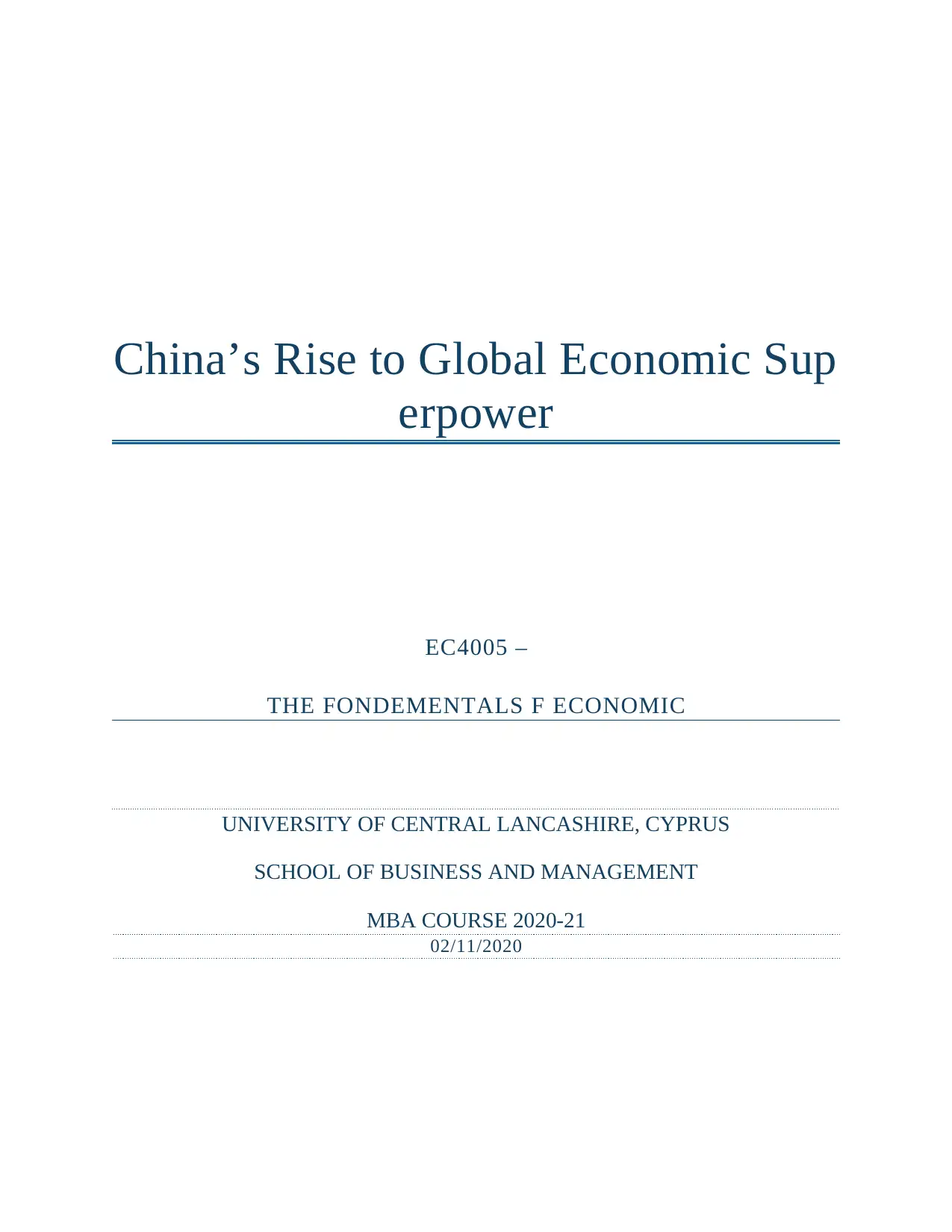
China’s Rise to Global Economic Sup
erpower
EC4005 –
THE FONDEMENTALS F ECONOMIC
UNIVERSITY OF CENTRAL LANCASHIRE, CYPRUS
SCHOOL OF BUSINESS AND MANAGEMENT
MBA COURSE 2020-21
02/11/2020
erpower
EC4005 –
THE FONDEMENTALS F ECONOMIC
UNIVERSITY OF CENTRAL LANCASHIRE, CYPRUS
SCHOOL OF BUSINESS AND MANAGEMENT
MBA COURSE 2020-21
02/11/2020
Paraphrase This Document
Need a fresh take? Get an instant paraphrase of this document with our AI Paraphraser
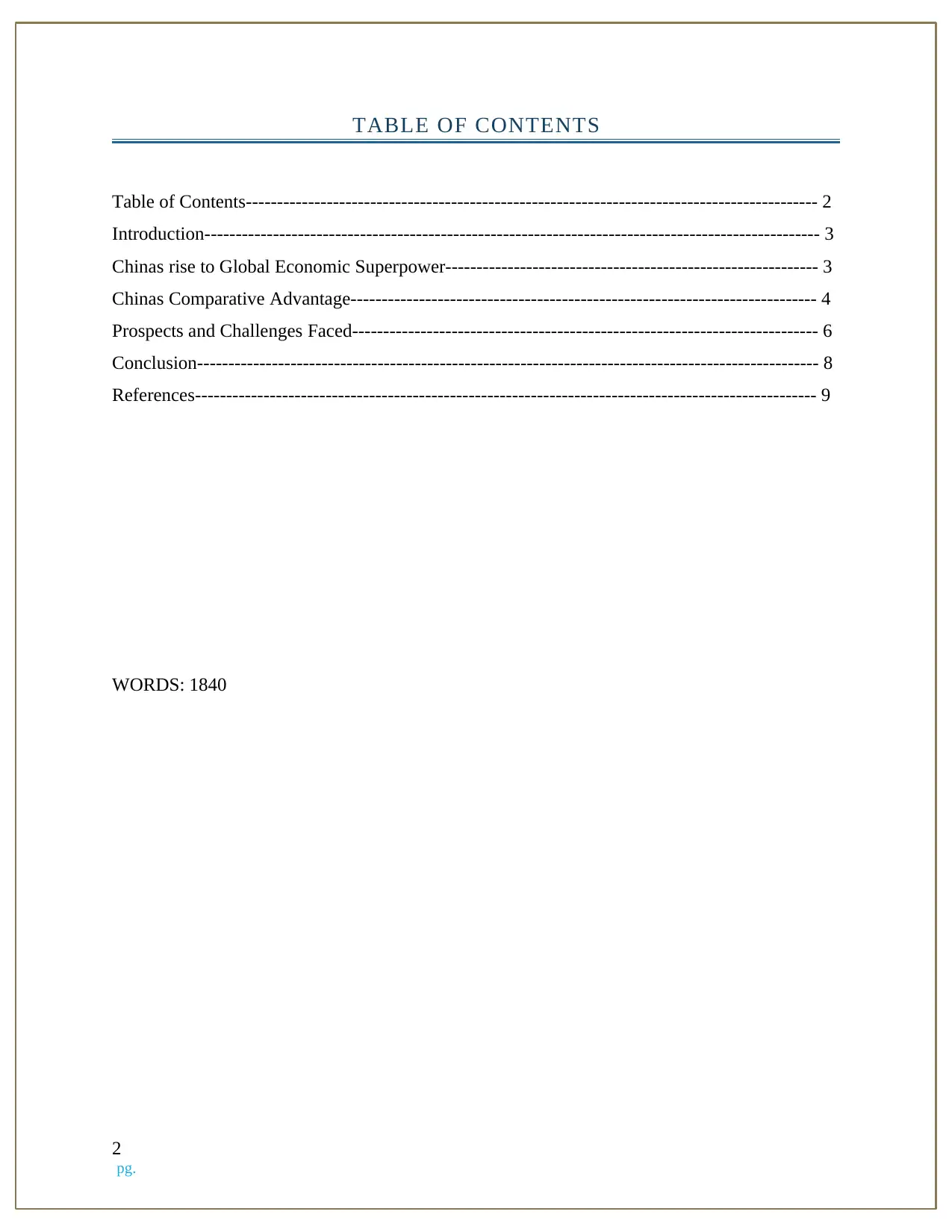
TABLE OF CONTENTS
Table of Contents-------------------------------------------------------------------------------------------- 2
Introduction--------------------------------------------------------------------------------------------------- 3
Chinas rise to Global Economic Superpower------------------------------------------------------------ 3
Chinas Comparative Advantage--------------------------------------------------------------------------- 4
Prospects and Challenges Faced--------------------------------------------------------------------------- 6
Conclusion---------------------------------------------------------------------------------------------------- 8
References---------------------------------------------------------------------------------------------------- 9
WORDS: 1840
2
pg.
Table of Contents-------------------------------------------------------------------------------------------- 2
Introduction--------------------------------------------------------------------------------------------------- 3
Chinas rise to Global Economic Superpower------------------------------------------------------------ 3
Chinas Comparative Advantage--------------------------------------------------------------------------- 4
Prospects and Challenges Faced--------------------------------------------------------------------------- 6
Conclusion---------------------------------------------------------------------------------------------------- 8
References---------------------------------------------------------------------------------------------------- 9
WORDS: 1840
2
pg.
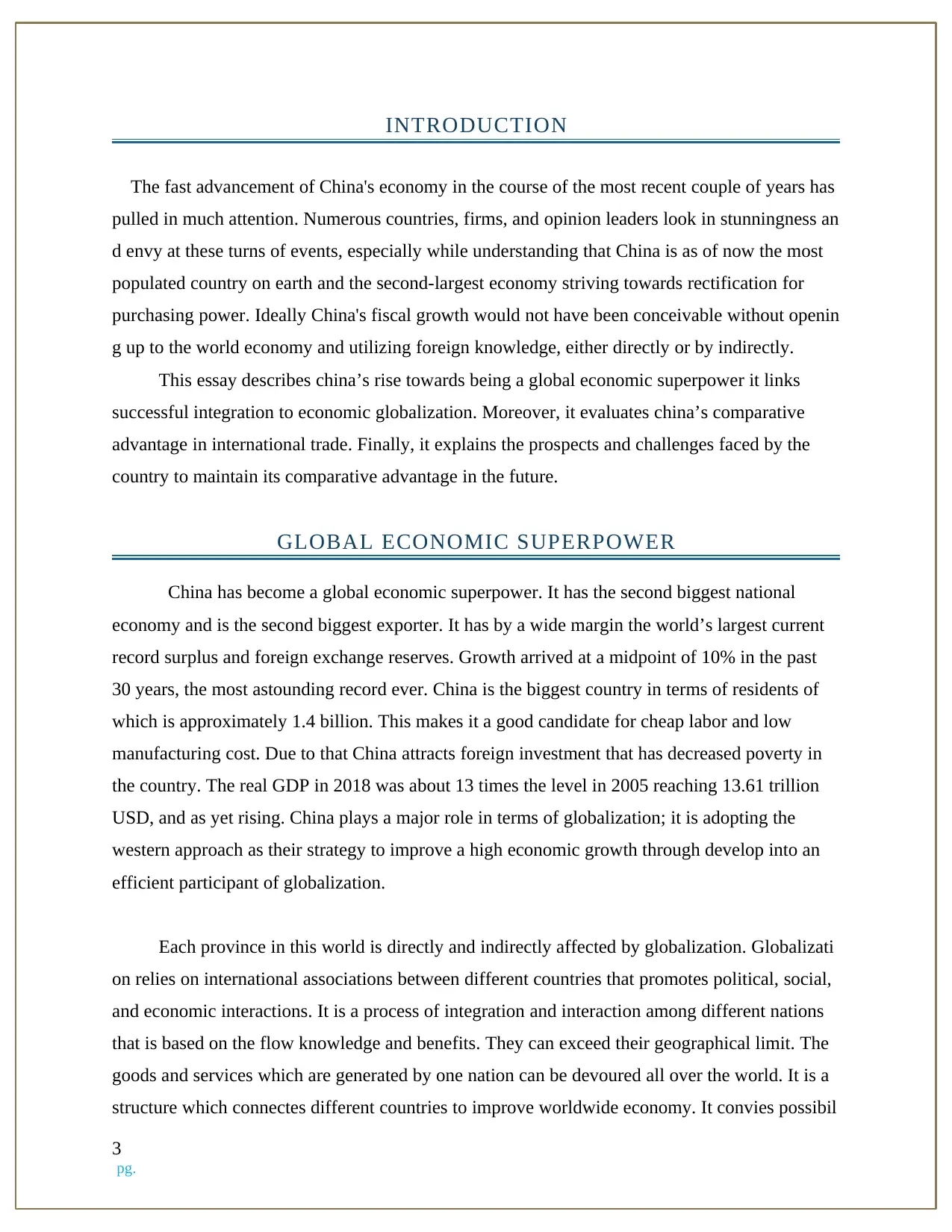
INTRODUCTION
The fast advancement of China's economy in the course of the most recent couple of years has
pulled in much attention. Numerous countries, firms, and opinion leaders look in stunningness an
d envy at these turns of events, especially while understanding that China is as of now the most
populated country on earth and the second-largest economy striving towards rectification for
purchasing power. Ideally China's fiscal growth would not have been conceivable without openin
g up to the world economy and utilizing foreign knowledge, either directly or by indirectly.
This essay describes china’s rise towards being a global economic superpower it links
successful integration to economic globalization. Moreover, it evaluates china’s comparative
advantage in international trade. Finally, it explains the prospects and challenges faced by the
country to maintain its comparative advantage in the future.
GLOBAL ECONOMIC SUPERPOWER
China has become a global economic superpower. It has the second biggest national
economy and is the second biggest exporter. It has by a wide margin the world’s largest current
record surplus and foreign exchange reserves. Growth arrived at a midpoint of 10% in the past
30 years, the most astounding record ever. China is the biggest country in terms of residents of
which is approximately 1.4 billion. This makes it a good candidate for cheap labor and low
manufacturing cost. Due to that China attracts foreign investment that has decreased poverty in
the country. The real GDP in 2018 was about 13 times the level in 2005 reaching 13.61 trillion
USD, and as yet rising. China plays a major role in terms of globalization; it is adopting the
western approach as their strategy to improve a high economic growth through develop into an
efficient participant of globalization.
Each province in this world is directly and indirectly affected by globalization. Globalizati
on relies on international associations between different countries that promotes political, social,
and economic interactions. It is a process of integration and interaction among different nations
that is based on the flow knowledge and benefits. They can exceed their geographical limit. The
goods and services which are generated by one nation can be devoured all over the world. It is a
structure which connectes different countries to improve worldwide economy. It convies possibil
3
pg.
The fast advancement of China's economy in the course of the most recent couple of years has
pulled in much attention. Numerous countries, firms, and opinion leaders look in stunningness an
d envy at these turns of events, especially while understanding that China is as of now the most
populated country on earth and the second-largest economy striving towards rectification for
purchasing power. Ideally China's fiscal growth would not have been conceivable without openin
g up to the world economy and utilizing foreign knowledge, either directly or by indirectly.
This essay describes china’s rise towards being a global economic superpower it links
successful integration to economic globalization. Moreover, it evaluates china’s comparative
advantage in international trade. Finally, it explains the prospects and challenges faced by the
country to maintain its comparative advantage in the future.
GLOBAL ECONOMIC SUPERPOWER
China has become a global economic superpower. It has the second biggest national
economy and is the second biggest exporter. It has by a wide margin the world’s largest current
record surplus and foreign exchange reserves. Growth arrived at a midpoint of 10% in the past
30 years, the most astounding record ever. China is the biggest country in terms of residents of
which is approximately 1.4 billion. This makes it a good candidate for cheap labor and low
manufacturing cost. Due to that China attracts foreign investment that has decreased poverty in
the country. The real GDP in 2018 was about 13 times the level in 2005 reaching 13.61 trillion
USD, and as yet rising. China plays a major role in terms of globalization; it is adopting the
western approach as their strategy to improve a high economic growth through develop into an
efficient participant of globalization.
Each province in this world is directly and indirectly affected by globalization. Globalizati
on relies on international associations between different countries that promotes political, social,
and economic interactions. It is a process of integration and interaction among different nations
that is based on the flow knowledge and benefits. They can exceed their geographical limit. The
goods and services which are generated by one nation can be devoured all over the world. It is a
structure which connectes different countries to improve worldwide economy. It convies possibil
3
pg.
⊘ This is a preview!⊘
Do you want full access?
Subscribe today to unlock all pages.

Trusted by 1+ million students worldwide
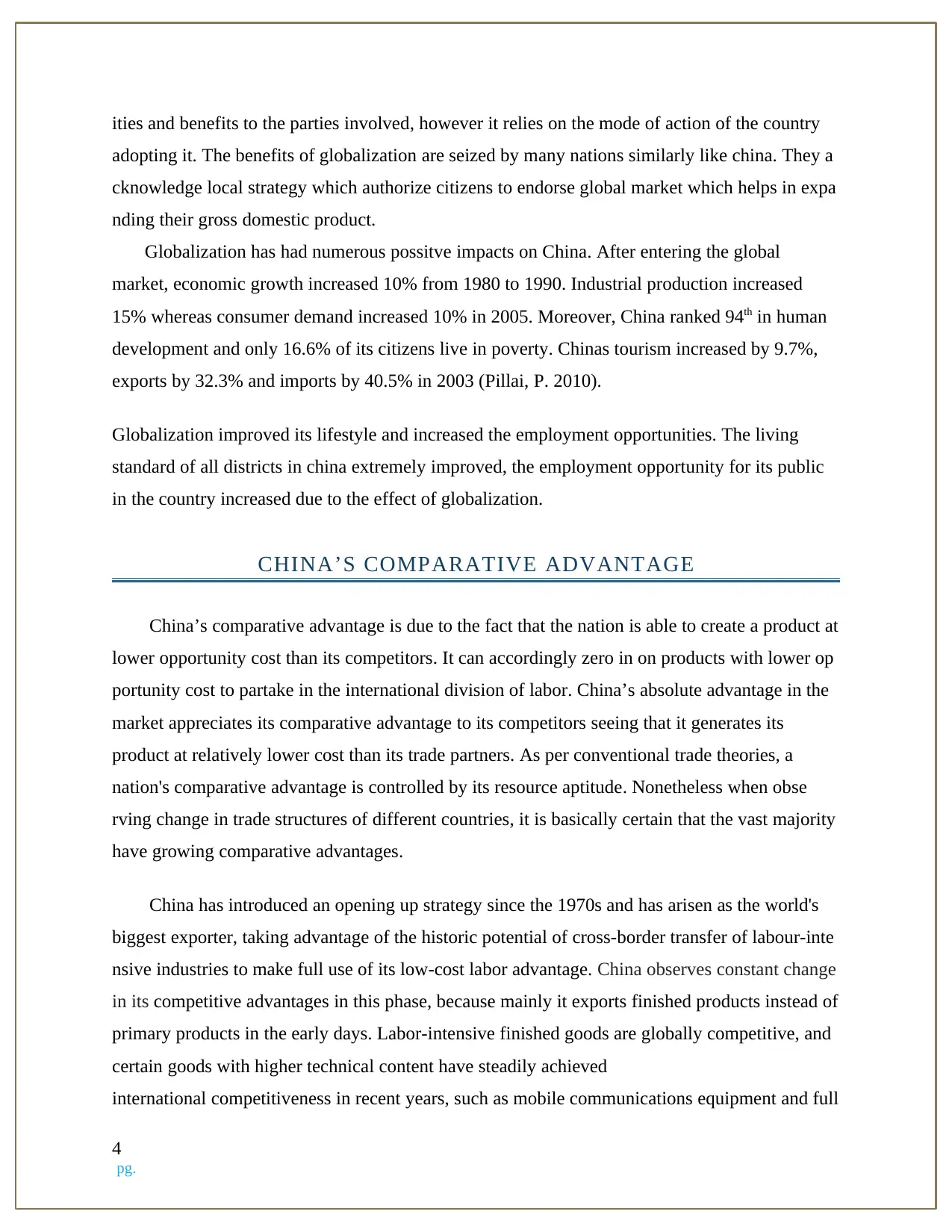
ities and benefits to the parties involved, however it relies on the mode of action of the country
adopting it. The benefits of globalization are seized by many nations similarly like china. They a
cknowledge local strategy which authorize citizens to endorse global market which helps in expa
nding their gross domestic product.
Globalization has had numerous possitve impacts on China. After entering the global
market, economic growth increased 10% from 1980 to 1990. Industrial production increased
15% whereas consumer demand increased 10% in 2005. Moreover, China ranked 94th in human
development and only 16.6% of its citizens live in poverty. Chinas tourism increased by 9.7%,
exports by 32.3% and imports by 40.5% in 2003 (Pillai, P. 2010).
Globalization improved its lifestyle and increased the employment opportunities. The living
standard of all districts in china extremely improved, the employment opportunity for its public
in the country increased due to the effect of globalization.
CHINA’S COMPARATIVE ADVANTAGE
China’s comparative advantage is due to the fact that the nation is able to create a product at
lower opportunity cost than its competitors. It can accordingly zero in on products with lower op
portunity cost to partake in the international division of labor. China’s absolute advantage in the
market appreciates its comparative advantage to its competitors seeing that it generates its
product at relatively lower cost than its trade partners. As per conventional trade theories, a
nation's comparative advantage is controlled by its resource aptitude. Nonetheless when obse
rving change in trade structures of different countries, it is basically certain that the vast majority
have growing comparative advantages.
China has introduced an opening up strategy since the 1970s and has arisen as the world's
biggest exporter, taking advantage of the historic potential of cross-border transfer of labour-inte
nsive industries to make full use of its low-cost labor advantage. China observes constant change
in its competitive advantages in this phase, because mainly it exports finished products instead of
primary products in the early days. Labor-intensive finished goods are globally competitive, and
certain goods with higher technical content have steadily achieved
international competitiveness in recent years, such as mobile communications equipment and full
4
pg.
adopting it. The benefits of globalization are seized by many nations similarly like china. They a
cknowledge local strategy which authorize citizens to endorse global market which helps in expa
nding their gross domestic product.
Globalization has had numerous possitve impacts on China. After entering the global
market, economic growth increased 10% from 1980 to 1990. Industrial production increased
15% whereas consumer demand increased 10% in 2005. Moreover, China ranked 94th in human
development and only 16.6% of its citizens live in poverty. Chinas tourism increased by 9.7%,
exports by 32.3% and imports by 40.5% in 2003 (Pillai, P. 2010).
Globalization improved its lifestyle and increased the employment opportunities. The living
standard of all districts in china extremely improved, the employment opportunity for its public
in the country increased due to the effect of globalization.
CHINA’S COMPARATIVE ADVANTAGE
China’s comparative advantage is due to the fact that the nation is able to create a product at
lower opportunity cost than its competitors. It can accordingly zero in on products with lower op
portunity cost to partake in the international division of labor. China’s absolute advantage in the
market appreciates its comparative advantage to its competitors seeing that it generates its
product at relatively lower cost than its trade partners. As per conventional trade theories, a
nation's comparative advantage is controlled by its resource aptitude. Nonetheless when obse
rving change in trade structures of different countries, it is basically certain that the vast majority
have growing comparative advantages.
China has introduced an opening up strategy since the 1970s and has arisen as the world's
biggest exporter, taking advantage of the historic potential of cross-border transfer of labour-inte
nsive industries to make full use of its low-cost labor advantage. China observes constant change
in its competitive advantages in this phase, because mainly it exports finished products instead of
primary products in the early days. Labor-intensive finished goods are globally competitive, and
certain goods with higher technical content have steadily achieved
international competitiveness in recent years, such as mobile communications equipment and full
4
pg.
Paraphrase This Document
Need a fresh take? Get an instant paraphrase of this document with our AI Paraphraser
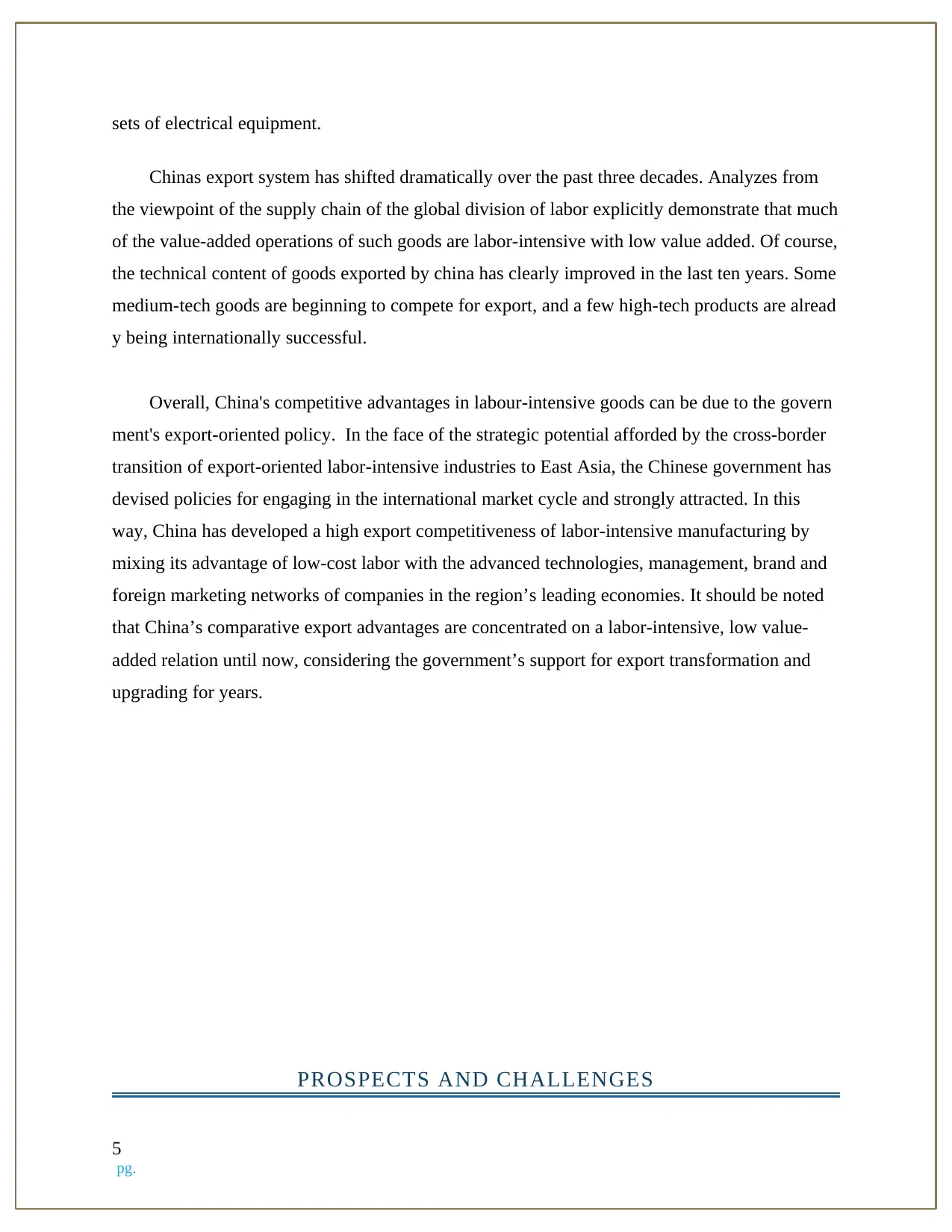
sets of electrical equipment.
Chinas export system has shifted dramatically over the past three decades. Analyzes from
the viewpoint of the supply chain of the global division of labor explicitly demonstrate that much
of the value-added operations of such goods are labor-intensive with low value added. Of course,
the technical content of goods exported by china has clearly improved in the last ten years. Some
medium-tech goods are beginning to compete for export, and a few high-tech products are alread
y being internationally successful.
Overall, China's competitive advantages in labour-intensive goods can be due to the govern
ment's export-oriented policy. In the face of the strategic potential afforded by the cross-border
transition of export-oriented labor-intensive industries to East Asia, the Chinese government has
devised policies for engaging in the international market cycle and strongly attracted. In this
way, China has developed a high export competitiveness of labor-intensive manufacturing by
mixing its advantage of low-cost labor with the advanced technologies, management, brand and
foreign marketing networks of companies in the region’s leading economies. It should be noted
that China’s comparative export advantages are concentrated on a labor-intensive, low value-
added relation until now, considering the government’s support for export transformation and
upgrading for years.
PROSPECTS AND CHALLENGES
5
pg.
Chinas export system has shifted dramatically over the past three decades. Analyzes from
the viewpoint of the supply chain of the global division of labor explicitly demonstrate that much
of the value-added operations of such goods are labor-intensive with low value added. Of course,
the technical content of goods exported by china has clearly improved in the last ten years. Some
medium-tech goods are beginning to compete for export, and a few high-tech products are alread
y being internationally successful.
Overall, China's competitive advantages in labour-intensive goods can be due to the govern
ment's export-oriented policy. In the face of the strategic potential afforded by the cross-border
transition of export-oriented labor-intensive industries to East Asia, the Chinese government has
devised policies for engaging in the international market cycle and strongly attracted. In this
way, China has developed a high export competitiveness of labor-intensive manufacturing by
mixing its advantage of low-cost labor with the advanced technologies, management, brand and
foreign marketing networks of companies in the region’s leading economies. It should be noted
that China’s comparative export advantages are concentrated on a labor-intensive, low value-
added relation until now, considering the government’s support for export transformation and
upgrading for years.
PROSPECTS AND CHALLENGES
5
pg.
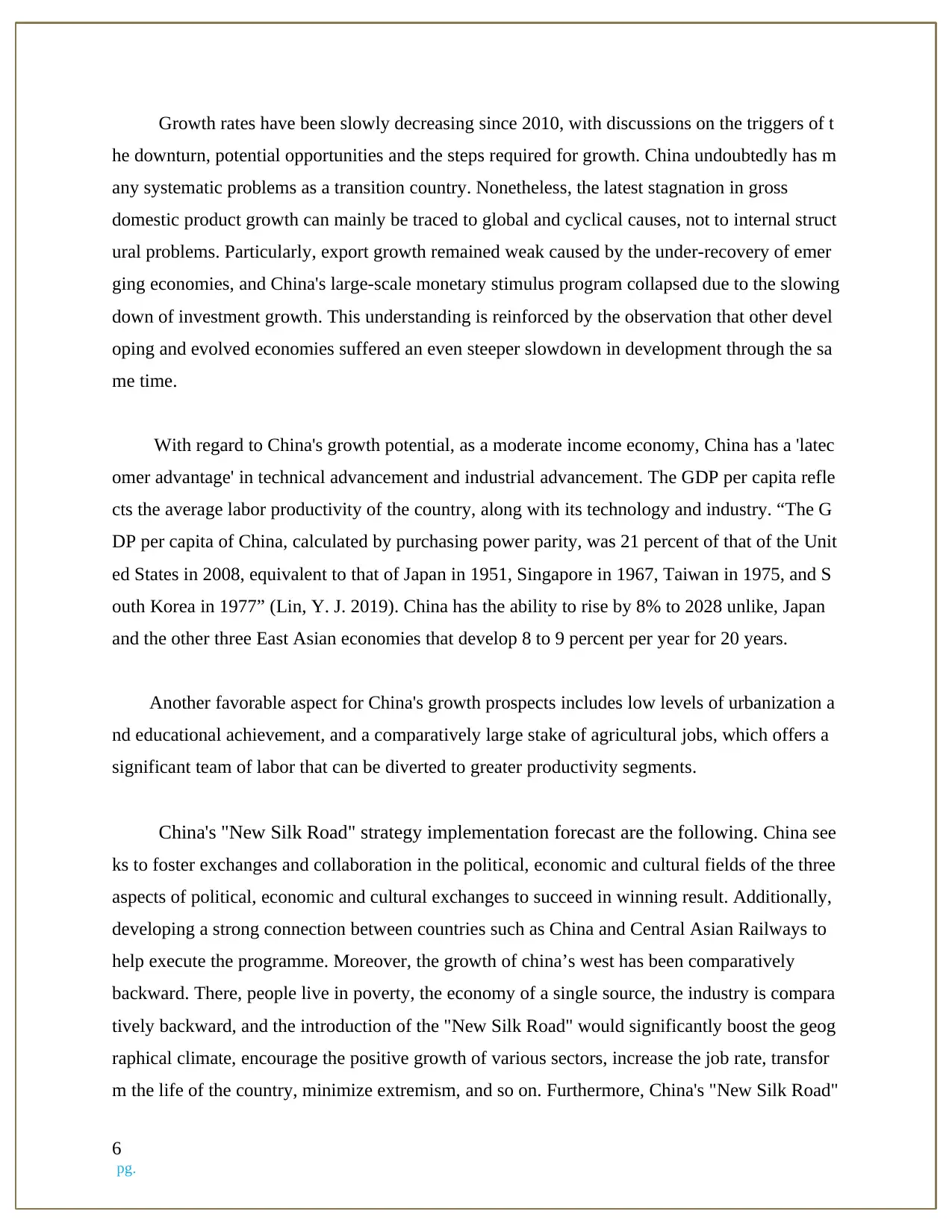
Growth rates have been slowly decreasing since 2010, with discussions on the triggers of t
he downturn, potential opportunities and the steps required for growth. China undoubtedly has m
any systematic problems as a transition country. Nonetheless, the latest stagnation in gross
domestic product growth can mainly be traced to global and cyclical causes, not to internal struct
ural problems. Particularly, export growth remained weak caused by the under-recovery of emer
ging economies, and China's large-scale monetary stimulus program collapsed due to the slowing
down of investment growth. This understanding is reinforced by the observation that other devel
oping and evolved economies suffered an even steeper slowdown in development through the sa
me time.
With regard to China's growth potential, as a moderate income economy, China has a 'latec
omer advantage' in technical advancement and industrial advancement. The GDP per capita refle
cts the average labor productivity of the country, along with its technology and industry. “The G
DP per capita of China, calculated by purchasing power parity, was 21 percent of that of the Unit
ed States in 2008, equivalent to that of Japan in 1951, Singapore in 1967, Taiwan in 1975, and S
outh Korea in 1977” (Lin, Y. J. 2019). China has the ability to rise by 8% to 2028 unlike, Japan
and the other three East Asian economies that develop 8 to 9 percent per year for 20 years.
Another favorable aspect for China's growth prospects includes low levels of urbanization a
nd educational achievement, and a comparatively large stake of agricultural jobs, which offers a
significant team of labor that can be diverted to greater productivity segments.
China's "New Silk Road" strategy implementation forecast are the following. China see
ks to foster exchanges and collaboration in the political, economic and cultural fields of the three
aspects of political, economic and cultural exchanges to succeed in winning result. Additionally,
developing a strong connection between countries such as China and Central Asian Railways to
help execute the programme. Moreover, the growth of china’s west has been comparatively
backward. There, people live in poverty, the economy of a single source, the industry is compara
tively backward, and the introduction of the "New Silk Road" would significantly boost the geog
raphical climate, encourage the positive growth of various sectors, increase the job rate, transfor
m the life of the country, minimize extremism, and so on. Furthermore, China's "New Silk Road"
6
pg.
he downturn, potential opportunities and the steps required for growth. China undoubtedly has m
any systematic problems as a transition country. Nonetheless, the latest stagnation in gross
domestic product growth can mainly be traced to global and cyclical causes, not to internal struct
ural problems. Particularly, export growth remained weak caused by the under-recovery of emer
ging economies, and China's large-scale monetary stimulus program collapsed due to the slowing
down of investment growth. This understanding is reinforced by the observation that other devel
oping and evolved economies suffered an even steeper slowdown in development through the sa
me time.
With regard to China's growth potential, as a moderate income economy, China has a 'latec
omer advantage' in technical advancement and industrial advancement. The GDP per capita refle
cts the average labor productivity of the country, along with its technology and industry. “The G
DP per capita of China, calculated by purchasing power parity, was 21 percent of that of the Unit
ed States in 2008, equivalent to that of Japan in 1951, Singapore in 1967, Taiwan in 1975, and S
outh Korea in 1977” (Lin, Y. J. 2019). China has the ability to rise by 8% to 2028 unlike, Japan
and the other three East Asian economies that develop 8 to 9 percent per year for 20 years.
Another favorable aspect for China's growth prospects includes low levels of urbanization a
nd educational achievement, and a comparatively large stake of agricultural jobs, which offers a
significant team of labor that can be diverted to greater productivity segments.
China's "New Silk Road" strategy implementation forecast are the following. China see
ks to foster exchanges and collaboration in the political, economic and cultural fields of the three
aspects of political, economic and cultural exchanges to succeed in winning result. Additionally,
developing a strong connection between countries such as China and Central Asian Railways to
help execute the programme. Moreover, the growth of china’s west has been comparatively
backward. There, people live in poverty, the economy of a single source, the industry is compara
tively backward, and the introduction of the "New Silk Road" would significantly boost the geog
raphical climate, encourage the positive growth of various sectors, increase the job rate, transfor
m the life of the country, minimize extremism, and so on. Furthermore, China's "New Silk Road"
6
pg.
⊘ This is a preview!⊘
Do you want full access?
Subscribe today to unlock all pages.

Trusted by 1+ million students worldwide
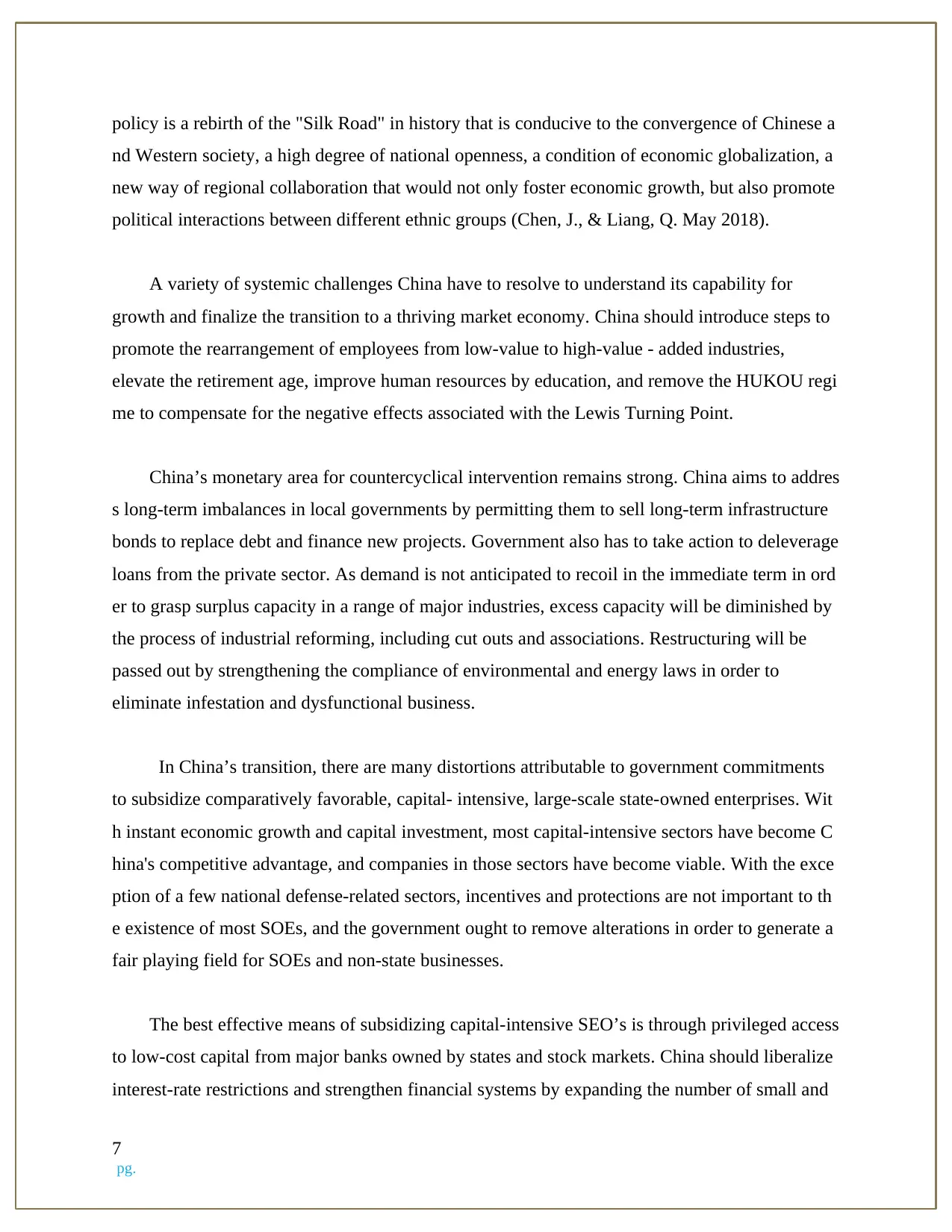
policy is a rebirth of the "Silk Road" in history that is conducive to the convergence of Chinese a
nd Western society, a high degree of national openness, a condition of economic globalization, a
new way of regional collaboration that would not only foster economic growth, but also promote
political interactions between different ethnic groups (Chen, J., & Liang, Q. May 2018).
A variety of systemic challenges China have to resolve to understand its capability for
growth and finalize the transition to a thriving market economy. China should introduce steps to
promote the rearrangement of employees from low-value to high-value - added industries,
elevate the retirement age, improve human resources by education, and remove the HUKOU regi
me to compensate for the negative effects associated with the Lewis Turning Point.
China’s monetary area for countercyclical intervention remains strong. China aims to addres
s long-term imbalances in local governments by permitting them to sell long-term infrastructure
bonds to replace debt and finance new projects. Government also has to take action to deleverage
loans from the private sector. As demand is not anticipated to recoil in the immediate term in ord
er to grasp surplus capacity in a range of major industries, excess capacity will be diminished by
the process of industrial reforming, including cut outs and associations. Restructuring will be
passed out by strengthening the compliance of environmental and energy laws in order to
eliminate infestation and dysfunctional business.
In China’s transition, there are many distortions attributable to government commitments
to subsidize comparatively favorable, capital- intensive, large-scale state-owned enterprises. Wit
h instant economic growth and capital investment, most capital-intensive sectors have become C
hina's competitive advantage, and companies in those sectors have become viable. With the exce
ption of a few national defense-related sectors, incentives and protections are not important to th
e existence of most SOEs, and the government ought to remove alterations in order to generate a
fair playing field for SOEs and non-state businesses.
The best effective means of subsidizing capital-intensive SEO’s is through privileged access
to low-cost capital from major banks owned by states and stock markets. China should liberalize
interest-rate restrictions and strengthen financial systems by expanding the number of small and
7
pg.
nd Western society, a high degree of national openness, a condition of economic globalization, a
new way of regional collaboration that would not only foster economic growth, but also promote
political interactions between different ethnic groups (Chen, J., & Liang, Q. May 2018).
A variety of systemic challenges China have to resolve to understand its capability for
growth and finalize the transition to a thriving market economy. China should introduce steps to
promote the rearrangement of employees from low-value to high-value - added industries,
elevate the retirement age, improve human resources by education, and remove the HUKOU regi
me to compensate for the negative effects associated with the Lewis Turning Point.
China’s monetary area for countercyclical intervention remains strong. China aims to addres
s long-term imbalances in local governments by permitting them to sell long-term infrastructure
bonds to replace debt and finance new projects. Government also has to take action to deleverage
loans from the private sector. As demand is not anticipated to recoil in the immediate term in ord
er to grasp surplus capacity in a range of major industries, excess capacity will be diminished by
the process of industrial reforming, including cut outs and associations. Restructuring will be
passed out by strengthening the compliance of environmental and energy laws in order to
eliminate infestation and dysfunctional business.
In China’s transition, there are many distortions attributable to government commitments
to subsidize comparatively favorable, capital- intensive, large-scale state-owned enterprises. Wit
h instant economic growth and capital investment, most capital-intensive sectors have become C
hina's competitive advantage, and companies in those sectors have become viable. With the exce
ption of a few national defense-related sectors, incentives and protections are not important to th
e existence of most SOEs, and the government ought to remove alterations in order to generate a
fair playing field for SOEs and non-state businesses.
The best effective means of subsidizing capital-intensive SEO’s is through privileged access
to low-cost capital from major banks owned by states and stock markets. China should liberalize
interest-rate restrictions and strengthen financial systems by expanding the number of small and
7
pg.
Paraphrase This Document
Need a fresh take? Get an instant paraphrase of this document with our AI Paraphraser
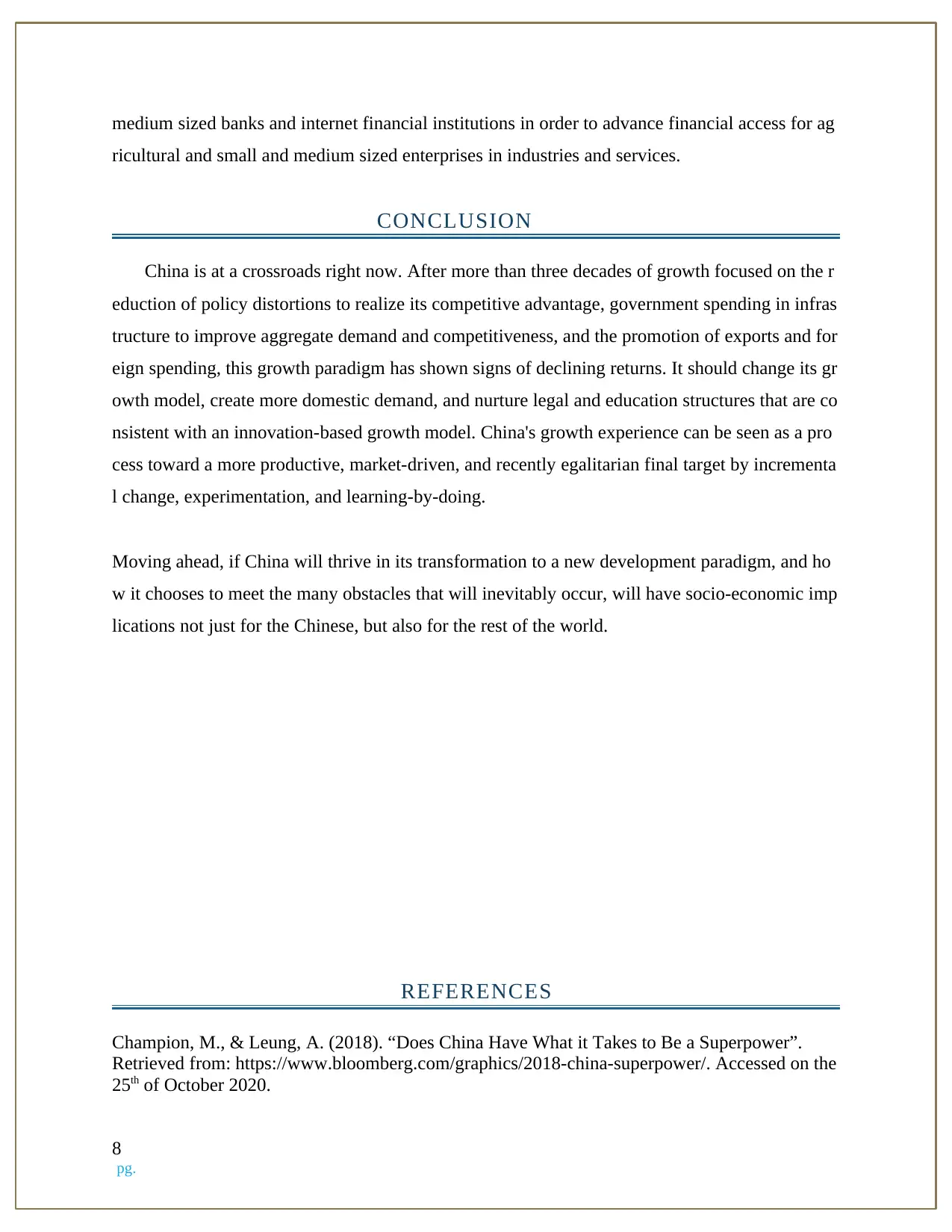
medium sized banks and internet financial institutions in order to advance financial access for ag
ricultural and small and medium sized enterprises in industries and services.
CONCLUSION
China is at a crossroads right now. After more than three decades of growth focused on the r
eduction of policy distortions to realize its competitive advantage, government spending in infras
tructure to improve aggregate demand and competitiveness, and the promotion of exports and for
eign spending, this growth paradigm has shown signs of declining returns. It should change its gr
owth model, create more domestic demand, and nurture legal and education structures that are co
nsistent with an innovation-based growth model. China's growth experience can be seen as a pro
cess toward a more productive, market-driven, and recently egalitarian final target by incrementa
l change, experimentation, and learning-by-doing.
Moving ahead, if China will thrive in its transformation to a new development paradigm, and ho
w it chooses to meet the many obstacles that will inevitably occur, will have socio-economic imp
lications not just for the Chinese, but also for the rest of the world.
REFERENCES
Champion, M., & Leung, A. (2018). “Does China Have What it Takes to Be a Superpower”.
Retrieved from: https://www.bloomberg.com/graphics/2018-china-superpower/. Accessed on the
25th of October 2020.
8
pg.
ricultural and small and medium sized enterprises in industries and services.
CONCLUSION
China is at a crossroads right now. After more than three decades of growth focused on the r
eduction of policy distortions to realize its competitive advantage, government spending in infras
tructure to improve aggregate demand and competitiveness, and the promotion of exports and for
eign spending, this growth paradigm has shown signs of declining returns. It should change its gr
owth model, create more domestic demand, and nurture legal and education structures that are co
nsistent with an innovation-based growth model. China's growth experience can be seen as a pro
cess toward a more productive, market-driven, and recently egalitarian final target by incrementa
l change, experimentation, and learning-by-doing.
Moving ahead, if China will thrive in its transformation to a new development paradigm, and ho
w it chooses to meet the many obstacles that will inevitably occur, will have socio-economic imp
lications not just for the Chinese, but also for the rest of the world.
REFERENCES
Champion, M., & Leung, A. (2018). “Does China Have What it Takes to Be a Superpower”.
Retrieved from: https://www.bloomberg.com/graphics/2018-china-superpower/. Accessed on the
25th of October 2020.
8
pg.
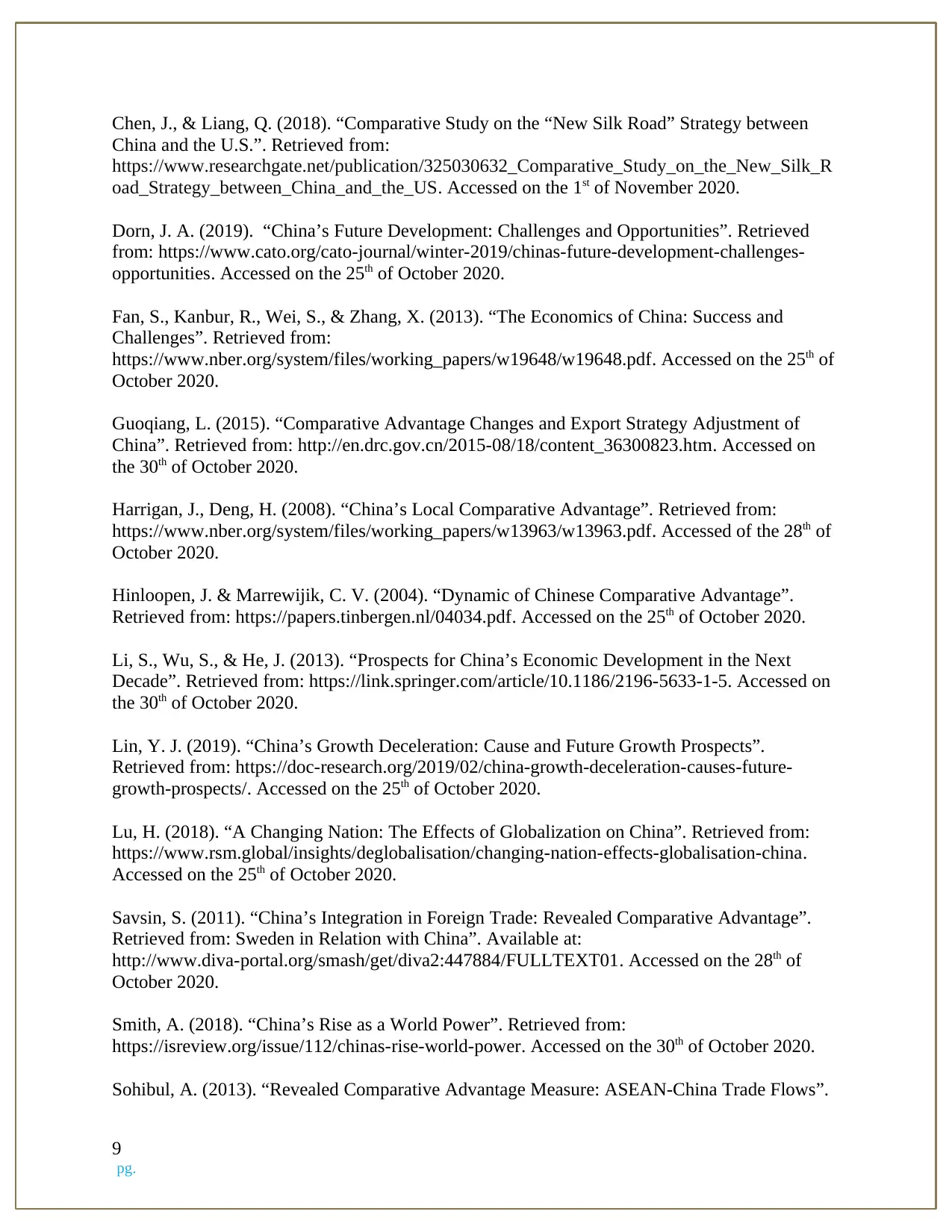
Chen, J., & Liang, Q. (2018). “Comparative Study on the “New Silk Road” Strategy between
China and the U.S.”. Retrieved from:
https://www.researchgate.net/publication/325030632_Comparative_Study_on_the_New_Silk_R
oad_Strategy_between_China_and_the_US. Accessed on the 1st of November 2020.
Dorn, J. A. (2019). “China’s Future Development: Challenges and Opportunities”. Retrieved
from: https://www.cato.org/cato-journal/winter-2019/chinas-future-development-challenges-
opportunities. Accessed on the 25th of October 2020.
Fan, S., Kanbur, R., Wei, S., & Zhang, X. (2013). “The Economics of China: Success and
Challenges”. Retrieved from:
https://www.nber.org/system/files/working_papers/w19648/w19648.pdf. Accessed on the 25th of
October 2020.
Guoqiang, L. (2015). “Comparative Advantage Changes and Export Strategy Adjustment of
China”. Retrieved from: http://en.drc.gov.cn/2015-08/18/content_36300823.htm. Accessed on
the 30th of October 2020.
Harrigan, J., Deng, H. (2008). “China’s Local Comparative Advantage”. Retrieved from:
https://www.nber.org/system/files/working_papers/w13963/w13963.pdf. Accessed of the 28th of
October 2020.
Hinloopen, J. & Marrewijik, C. V. (2004). “Dynamic of Chinese Comparative Advantage”.
Retrieved from: https://papers.tinbergen.nl/04034.pdf. Accessed on the 25th of October 2020.
Li, S., Wu, S., & He, J. (2013). “Prospects for China’s Economic Development in the Next
Decade”. Retrieved from: https://link.springer.com/article/10.1186/2196-5633-1-5. Accessed on
the 30th of October 2020.
Lin, Y. J. (2019). “China’s Growth Deceleration: Cause and Future Growth Prospects”.
Retrieved from: https://doc-research.org/2019/02/china-growth-deceleration-causes-future-
growth-prospects/. Accessed on the 25th of October 2020.
Lu, H. (2018). “A Changing Nation: The Effects of Globalization on China”. Retrieved from:
https://www.rsm.global/insights/deglobalisation/changing-nation-effects-globalisation-china.
Accessed on the 25th of October 2020.
Savsin, S. (2011). “China’s Integration in Foreign Trade: Revealed Comparative Advantage”.
Retrieved from: Sweden in Relation with China”. Available at:
http://www.diva-portal.org/smash/get/diva2:447884/FULLTEXT01. Accessed on the 28th of
October 2020.
Smith, A. (2018). “China’s Rise as a World Power”. Retrieved from:
https://isreview.org/issue/112/chinas-rise-world-power. Accessed on the 30th of October 2020.
Sohibul, A. (2013). “Revealed Comparative Advantage Measure: ASEAN-China Trade Flows”.
9
pg.
China and the U.S.”. Retrieved from:
https://www.researchgate.net/publication/325030632_Comparative_Study_on_the_New_Silk_R
oad_Strategy_between_China_and_the_US. Accessed on the 1st of November 2020.
Dorn, J. A. (2019). “China’s Future Development: Challenges and Opportunities”. Retrieved
from: https://www.cato.org/cato-journal/winter-2019/chinas-future-development-challenges-
opportunities. Accessed on the 25th of October 2020.
Fan, S., Kanbur, R., Wei, S., & Zhang, X. (2013). “The Economics of China: Success and
Challenges”. Retrieved from:
https://www.nber.org/system/files/working_papers/w19648/w19648.pdf. Accessed on the 25th of
October 2020.
Guoqiang, L. (2015). “Comparative Advantage Changes and Export Strategy Adjustment of
China”. Retrieved from: http://en.drc.gov.cn/2015-08/18/content_36300823.htm. Accessed on
the 30th of October 2020.
Harrigan, J., Deng, H. (2008). “China’s Local Comparative Advantage”. Retrieved from:
https://www.nber.org/system/files/working_papers/w13963/w13963.pdf. Accessed of the 28th of
October 2020.
Hinloopen, J. & Marrewijik, C. V. (2004). “Dynamic of Chinese Comparative Advantage”.
Retrieved from: https://papers.tinbergen.nl/04034.pdf. Accessed on the 25th of October 2020.
Li, S., Wu, S., & He, J. (2013). “Prospects for China’s Economic Development in the Next
Decade”. Retrieved from: https://link.springer.com/article/10.1186/2196-5633-1-5. Accessed on
the 30th of October 2020.
Lin, Y. J. (2019). “China’s Growth Deceleration: Cause and Future Growth Prospects”.
Retrieved from: https://doc-research.org/2019/02/china-growth-deceleration-causes-future-
growth-prospects/. Accessed on the 25th of October 2020.
Lu, H. (2018). “A Changing Nation: The Effects of Globalization on China”. Retrieved from:
https://www.rsm.global/insights/deglobalisation/changing-nation-effects-globalisation-china.
Accessed on the 25th of October 2020.
Savsin, S. (2011). “China’s Integration in Foreign Trade: Revealed Comparative Advantage”.
Retrieved from: Sweden in Relation with China”. Available at:
http://www.diva-portal.org/smash/get/diva2:447884/FULLTEXT01. Accessed on the 28th of
October 2020.
Smith, A. (2018). “China’s Rise as a World Power”. Retrieved from:
https://isreview.org/issue/112/chinas-rise-world-power. Accessed on the 30th of October 2020.
Sohibul, A. (2013). “Revealed Comparative Advantage Measure: ASEAN-China Trade Flows”.
9
pg.
⊘ This is a preview!⊘
Do you want full access?
Subscribe today to unlock all pages.

Trusted by 1+ million students worldwide
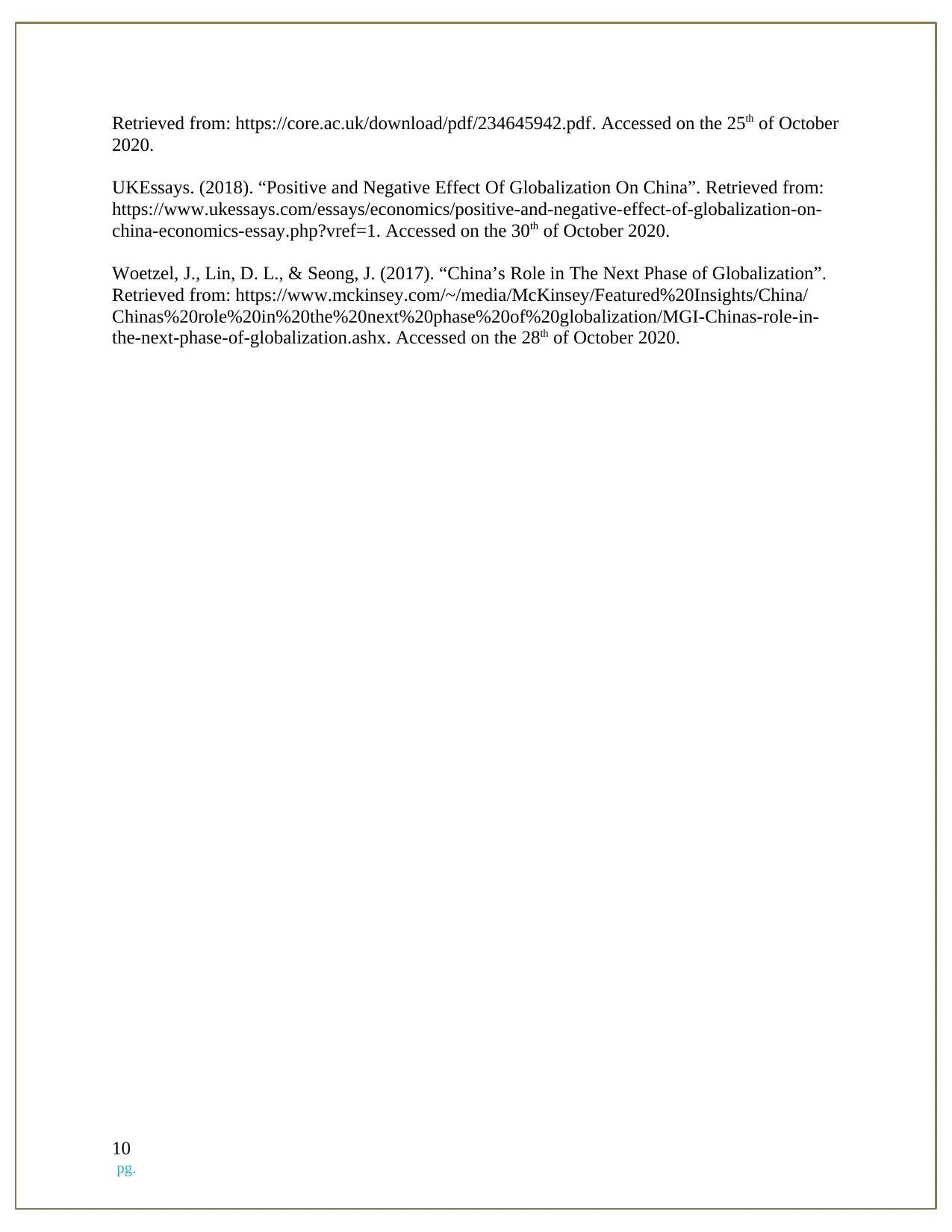
Retrieved from: https://core.ac.uk/download/pdf/234645942.pdf. Accessed on the 25th of October
2020.
UKEssays. (2018). “Positive and Negative Effect Of Globalization On China”. Retrieved from:
https://www.ukessays.com/essays/economics/positive-and-negative-effect-of-globalization-on-
china-economics-essay.php?vref=1. Accessed on the 30th of October 2020.
Woetzel, J., Lin, D. L., & Seong, J. (2017). “China’s Role in The Next Phase of Globalization”.
Retrieved from: https://www.mckinsey.com/~/media/McKinsey/Featured%20Insights/China/
Chinas%20role%20in%20the%20next%20phase%20of%20globalization/MGI-Chinas-role-in-
the-next-phase-of-globalization.ashx. Accessed on the 28th of October 2020.
10
pg.
2020.
UKEssays. (2018). “Positive and Negative Effect Of Globalization On China”. Retrieved from:
https://www.ukessays.com/essays/economics/positive-and-negative-effect-of-globalization-on-
china-economics-essay.php?vref=1. Accessed on the 30th of October 2020.
Woetzel, J., Lin, D. L., & Seong, J. (2017). “China’s Role in The Next Phase of Globalization”.
Retrieved from: https://www.mckinsey.com/~/media/McKinsey/Featured%20Insights/China/
Chinas%20role%20in%20the%20next%20phase%20of%20globalization/MGI-Chinas-role-in-
the-next-phase-of-globalization.ashx. Accessed on the 28th of October 2020.
10
pg.
1 out of 10
Related Documents
Your All-in-One AI-Powered Toolkit for Academic Success.
+13062052269
info@desklib.com
Available 24*7 on WhatsApp / Email
![[object Object]](/_next/static/media/star-bottom.7253800d.svg)
Unlock your academic potential
Copyright © 2020–2025 A2Z Services. All Rights Reserved. Developed and managed by ZUCOL.




